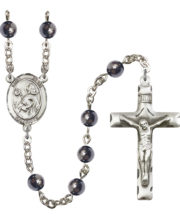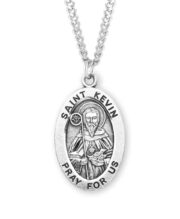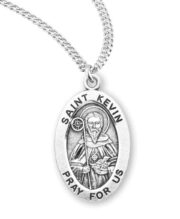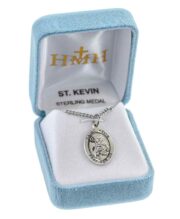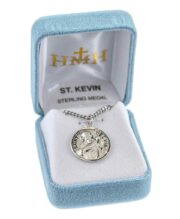Saints
St. Kevin
St. Kevin Biography
St. Kevin was an Irish monk, abbot, and bishop who lived in the 6th century. He is the patron saint of Dublin, Ireland and is known for his holiness, devotion to God, and kindness to animals.
Born in the year 498, Kevin was the son of Coemlog and Coemell, both of whom were members of the royal family of Leinster. He was educated at the monastery of Glendalough, where he later became a monk and dedicated himself to a life of prayer and service.
St. Kevin was known for his great love of nature and animals. It is said that he once saved a blackbird by holding it in his hand until it had recovered from an injury. He also built a small cell in a tree, where he would spend long hours in prayer and contemplation.
In addition to his devotion to God, St. Kevin was also known for his charitable work. He founded a monastery at Glendalough and built a hospital for the sick and poor. He was known for his kindness and generosity, and was often called upon to mediate disputes and bring peace to troubled areas.
St. Kevin died in the year 618 at the age of 120. He is remembered as a saint and a great spiritual leader, and his legacy lives on through the many churches and institutions that bear his name. St. Kevin is the patron saint of Dublin and his feast day is on June 3rd.
Popular St. Kevin Medal
Detailed Biography of St. Kevin: A Hermit, A Miracle Worker, and A Patron Saint of Dublin
Early Life and Education
Journey to Glendalough
Hermitage and Connection with Nature
Establishment of the Monastic City
Miracles of St. Kevin
Death and Canonization
Prayers to St. Kevin
Prayer of Intercession to St. Kevin
St. Kevin, you were known for your kindness and compassion, especially towards the sick and the poor. You were a man of peace and reconciliation. Please intercede for me and all those in need of healing and comfort. Help me to be an instrument of peace in my own life and in the world around me.
Prayer to St. Kevin
Dear St. Kevin, you were a man of great faith and devotion to God. Please pray for me, that I may follow in your footsteps and grow closer to God in my own life. St. Kevin, you were a man of great wisdom and holiness. Please pray for me, that I may grow in understanding and love for God and for others. Amen.
Prayer to St. Kevin
St. Kevin, you loved and cared for all of God’s creation, including the animals. Please help me to have a heart of compassion for all of God’s creatures, and to respect and care for the natural world.
Miracles of St. Kevin
There are many stories and legends told about the miracles of St. Kevin. St. Kevin was an Irish monk, abbot, and bishop who lived in the 6th century and is known for his holiness, devotion to God, and kindness to animals.
One legend tells of how St. Kevin once saved a blackbird that had been injured. He is said to have held the bird in his hand until it had recovered, showing his great love and compassion for all of God’s creatures.
Another legend tells of how St. Kevin was once visited by an angel who brought him food. St. Kevin was so focused on his prayers that he did not notice the angel at first, and the food remained fresh and untouched until he finally stopped to eat it. This miracle is said to be a testament to St. Kevin’s great devotion to God.
There are also many stories of St. Kevin performing miraculous healings, both physical and spiritual. He was known for his charity and compassion, and is said to have had a special gift for bringing peace and healing to those in need.
Why is St. Kevin the patron saint of Dublin?
St. Kevin is the patron saint of Dublin, Ireland because he is believed to have founded a monastery at Glendalough, which is located near Dublin. St. Kevin was a monk and bishop who lived in the 6th century and is known for his holiness, devotion to God, and kindness to animals.
According to tradition, St. Kevin founded the monastery at Glendalough in the year 454 and it quickly became a center of learning and spirituality. St. Kevin was a beloved figure in the region and was known for his charitable work, including the building of a hospital for the sick and poor.
As the patron saint of Dublin, St. Kevin is remembered and venerated for his contributions to the city and for his example of holiness and service to others. His feast day is celebrated on June 3rd each year and his legacy lives on through the many churches and institutions that bear his name.
Children’s Story about the life of St. Kevin
In a land called Ireland, there was a boy named Kevin who grew up to be a very special man.
Kevin was born into a royal family, but he was not interested in wealth or power. He was more interested in living a simple life and serving God.
When he was a young boy, Kevin went to live at a monastery called Glendalough. There, he learned about God and how to pray. Kevin loved to spend time in nature and was known for his kindness to animals. One time, he even saved a blackbird that had been hurt by holding it in his hand until it was well again.
As he grew older, Kevin became a monk at Glendalough and dedicated his life to God. He was known for his deep love of prayer and his gentle spirit.
Kevin was also very generous and helped to build a hospital for the sick and poor. He was always ready to help others and was known for his kindness and compassion.
When Kevin was older, he became the leader of the monastery at Glendalough. He was a wise and fair leader and was loved by all who knew him.
Eventually, Kevin became a bishop and traveled all over Ireland to spread the message of God’s love. He was known as a great spiritual leader and many people turned to him for guidance and help.
Kevin lived to be a very old man and when he died, he was remembered as a saint. People all over Ireland celebrated his life and the love he had for God and others.
Even today, people still remember St. Kevin and pray to him for guidance and help. He is a reminder that even though we are just ordinary people, we can still do great things if we follow God’s will.
Reflection on the Feast of St. Kevin
Today, the Catholic Church celebrates the feast of St. Kevin on June 3rd. The feast day of St. Kevin, also known as St. Kevin’s Day, is celebrated on June 3rd each year. St. Kevin was an Irish monk, abbot, and bishop who lived in the 6th century. He is the patron saint of Dublin, Ireland and is known for his holiness, devotion to God, and kindness to animals.
On his feast day, Catholics and other Christians may attend Mass and pray for the intercession of St. Kevin. It is also a day to remember and reflect on the life and teachings of St. Kevin, and to ask for the guidance and inspiration of this holy man.
One way to reflect on the feast day of St. Kevin is to think about the qualities that he is known for and how we can strive to imitate them in our own lives. St. Kevin was a man of deep faith and devotion to God, and he lived a life of simplicity and service to others. He was known for his kindness and compassion, especially towards the sick and the poor.
As we celebrate the feast day of St. Kevin, we can take some time to pray for the grace to follow in his footsteps and to live our lives in a way that is pleasing to God. We can also ask for St. Kevin’s intercession and for the wisdom and guidance of this holy man as we seek to grow in our own faith and serve others.

